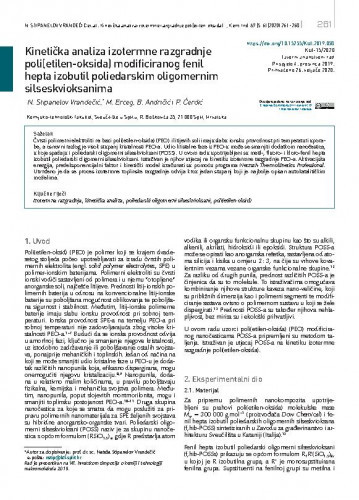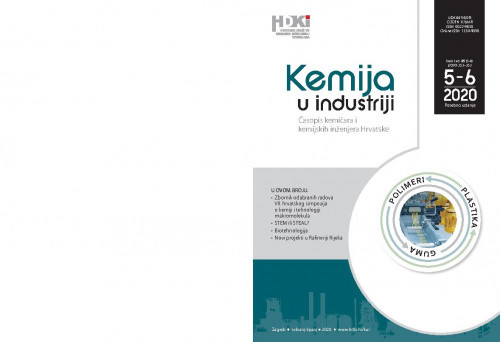Čvrsti polimerni elektroliti na bazi poli(etilen-oksida) (PEO) i litijevih soli imaju slabu ionsku provodnost pri temperaturi uporabe, a osnovni razlog je visok stupanj kristalnosti PEO-a. Udio kristalne faze u PEO-u može se smanjiti dodatkom nanočestica, u koje spadaju i poliedarski oligomerni silseskvioksani (POSS). U ovom radu upotrijebljeni su metil-, fluoro- i kloro-fenil hepta izobutil poliedarski oligomerni silseskvioksani. Istraživan je njihov utjecaj na kinetiku izotermne razgradnje PEO-a. Aktivacijska energija, predeksponencijalni faktor i kinetički model izračunati su pomoću programa Netzsch Thermokinetics Professional. Utvrđeno je da se proces izotermne toplinske razgradnje odvija kroz jedan stupanj koji je najbolje opisan autokatalitičkim modelima.; Poly(ethylene oxide) (PEO) and lithium salts based solid polymer electrolytes exhibit low ionic conductivity at the service temperatures, the main reason being the high crystallinity of PEO. Degree of crystallinity is often lowered by addition of nanoparticles, among them being a very interesting group known as polyhedral oligomeric silsesquioxanes (POSSs). In this work, the influence of POSS nanoparticles (methyl-, fluoro-, and chloro-phenil heptaisobutyl POSS) on kinetics of isothermal PEO degradation was investigated. Activation energy, pre-exponential factor, and kinetic model were determined using Netzsch Thermokinetics Professional program. It was found that the process of isothermal degradation occurs through one step, best described by autocatalytic models. According to Fig. 2 and Table 2, all investigated samples at 360, 370, and 380 °C after 60 min reach constant mass plateau with residual mass (mf) 3–7 %. In this temperature range, degradation of both PEO and POSSs occur. Before starting the kinetic analysis, the time necessary to gain isothermal conditions was subtracted. Activation energy (E) and pre-exponential factor (A) calculated using linear regression (LR), as well as the kinetic model of thermal degradation f(α) are summarised in Table 4. Activation energies of PEO/POSS 1, PEO/POSS 3 i PEO/POSS 5 samples are similar to those of PEO. The highest and lowest value of activation energy for PEO/POSS 4 and PEO/POSS 2 samples, respectively, is the result of their inherent thermal stability. Dependence of activation energy on conversion is of the same shape for all samples, implying the same mechanism of thermal degradation. DTG curves exhibit one degradation step only. Results of F-test (Table 3) indicate that extended Prout-Tompkins model as well as other autocatalytic models are statistically the best for description of the isothermal degradation of PEO and PEO/POSS composites.
Sažetak

 Kemija u industriji : 69,5/6 (2020) / glavni i odgovorni urednik Nenad Bolf.
Kemija u industriji : 69,5/6 (2020) / glavni i odgovorni urednik Nenad Bolf.